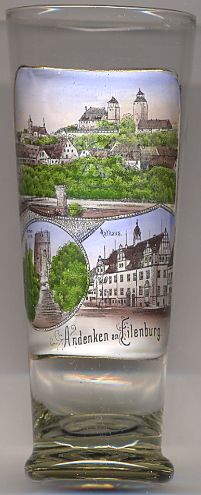

|
| DEUTSCHLAND | GERMANY |
| Bundesland: Freistaat Sachsen | Saxony |
| Landkreis: Nordsachsen |
 Eilenburg is situated at an elevation of 106 m on the river Mulde in northern Saxony, about 20 km
northeast of Leipzig. The municipality has a population of about 17,000 (2008).
Eilenburg is situated at an elevation of 106 m on the river Mulde in northern Saxony, about 20 km
northeast of Leipzig. The municipality has a population of about 17,000 (2008).
The earliest mention of Ilburg is found in a document of 961, but the oldest traces of humans date back to the early Stone Age. Slavic settlements at the river Mulde seem to go back to the 7th and 8th century. Eilenburg castle was probably founded during the course of the 9th century. During the early years of the Thirty Years' War (1618–1648), Eilenburg was spared but it began to suffer economically. In 1631 the war finally reached the town. King Gustav II Adolf of Sweden, who died on 16th November 1632 in the Battle of Lützen, was laid out in Eilenburg. In 1639 the town was captured by Swedish troops. In 1646 negotiations between Sweden and Saxony began here. The Peace of Eilenburg of 1648 ended the War for Saxony. After a period of economic recovery, the Seven Years' War (1756–1763) again caused severe hardships; the town was repeatedly captured by the opponents, Prussia and Austria. After the Napoleonic Wars, the Congress of Vienna (1815) awarded parts of northern Saxony, and with it Eilenburg, to Prussia and the town became part of the Prussian province Saxony. The Prussian reforms marked the beginning of economic growth. Eilenburg became the most important centre, apart from Berlin, of the Prussian textile industry. Further growth was initiated by the founding of the new railroads. The line from Halle via Eilenburg to Falkenberg was opened in 1872, the section from Eilenburg to Leipzig followed in 1874. New industries, especially wood and metal working, and celluloid production followed. At the end of World War II, almost the entire town was destroyed. During the 1950s, the town was rebuilt. In 1952, Eilenburg became the administrative seat of the district Eilenburg. In 1994, the district was incorporated into the district Delitzsch, which itself was merged with the district Torgau-Oschatz in 2008 to the new district Nordsachsen (Northern Saxony).
 Eilenburg castle [top picture] goes back to a Slavic stronghold that probably was founded in the 9th century.
Around 1000 it came in possession of the Wettin dynasty and remained their property, with interruptions, until 1918.
In the late 12th and early 13th century, the stronghold was greatly enlarged and received a curtain wall. During the ensuing centuries the castle was repeatedly
enlarged. By 1972, the castle keep had become derelict and threatened to collapse; therefore the keep was blown up and its remains were removed.
Parts of the castle were destroyed by a fire in 1993.
Eilenburg castle [top picture] goes back to a Slavic stronghold that probably was founded in the 9th century.
Around 1000 it came in possession of the Wettin dynasty and remained their property, with interruptions, until 1918.
In the late 12th and early 13th century, the stronghold was greatly enlarged and received a curtain wall. During the ensuing centuries the castle was repeatedly
enlarged. By 1972, the castle keep had become derelict and threatened to collapse; therefore the keep was blown up and its remains were removed.
Parts of the castle were destroyed by a fire in 1993.
The  Sorbenturm (Sorbs' Tower) [bottom left picture]
is part of Eilenburg castle. The tower is made of brickwork and dates back to the beginning 13th century.
Sorbenturm (Sorbs' Tower) [bottom left picture]
is part of Eilenburg castle. The tower is made of brickwork and dates back to the beginning 13th century.
The  Town Hall [bottom right picture] was first mentioned in 1403/1404 but this structure was
soon after destroyed by a fire. The next building, begun only in 1521, also fell victim to a fire after only 14 years.
The next town hall (which is depicted on the glass) was built in 1544/1545 in splendid Renaissance style. This structure marked the centre of Eilenburg until the end of
World War II, but was completely destroyed in April 1945. The present town hall was built only one year later; this structure was erected in much simpler
forms, but recreating a Renaissance character.
Town Hall [bottom right picture] was first mentioned in 1403/1404 but this structure was
soon after destroyed by a fire. The next building, begun only in 1521, also fell victim to a fire after only 14 years.
The next town hall (which is depicted on the glass) was built in 1544/1545 in splendid Renaissance style. This structure marked the centre of Eilenburg until the end of
World War II, but was completely destroyed in April 1945. The present town hall was built only one year later; this structure was erected in much simpler
forms, but recreating a Renaissance character.
![[scale]](lineal.jpg)